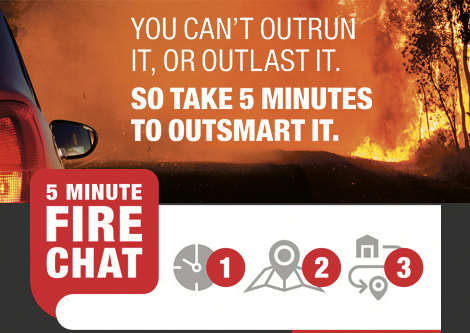You can’t outrun it, or outlast it. So, take 5 minutes to outsmart it. The Department of Fire and Emergency Services slogan for fire season preparation is short and to the point — bushfires are unpredictable and having to make decisions during a disaster can have fatal consequences. Your best chance of survival and minimisation of loss to property is to have a bushfire management plan.
Deciding whether you would leave early or stay and defend your property is the first conversation to have with members of your household. You should only plan to stay if you are mentally, physically and emotionally prepared to defend your property, and you have all the right equipment. The DFES website has an online questionnaire to help you decide whether you want to leave early or stay and defend in the event of a bushfire; either way you will need a plan!
The simplest form of a bushfire management plan is the 5 Minute Fire Chat. Discuss the answers to the following questions with your family; then when a bushfire is approaching you will have clear direction on how to deal with the emergency rather than having to make decisions under pressure.
1. When will you know to leave? Waiting to see flames before you evacuate is too late. Stay informed of the conditions —DFES publishes updates through several websites and emergency apps, Twitter and ABC local radio. Be alert and aware of your surroundings (if you smell smoke, pop your head outside and have a look before hopping on Facebook to see what is happening!), and stay in touch with neighbours.
2. Where will you go? Choose a safe place, like the home of a family member or friends that live away from the fire zone. In the event of evacuations due to bushfire the Department of Community Protection will have an evacuation centre established.
3. Which way will you go? Fires can come from any direction and paths can quickly become blocked. Choose more than one route to your safe place.
If you live in a bushfire danger zone, a rural area or have chosen to stay and defend your property you will need a more detailed plan. It is important to be aware of the Bushfire Warning System, which will help you decide when to act. The three levels of alerts (advice, watch and act, and emergency) provide information on the severity of a bushfire once it has started. The alert level reflects the risk to life and property (see image).
Many hours before the fire front arrives:
• Relocate other family members especially children and older people
• Turn air conditioner off but leave water running through the system if possible
• Fill all containers/basins with water – check all water supplies
• Soak blankets for protection against radiant heat
• Soak towels and rugs in water and lay alongside the inside of external doorways
• Take down curtains and move furniture away from windows
• Place ladder and torch close to manhole to check ceiling for embers
• Bring any loose burnable material inside
• Wet down side of house and garden that faces the fire front
• Block downpipes and fill gutters with water
• Regularly patrol around the home for spot fires
• Turn off gas supply
As the front approaches and during the fire:
• Bring all hoses, hose fittings (including plastic tap attachments) and all equipment inside
• Move everyone into the house when you see flames, or it becomes too hot
• Frequently check the roof cavity for spot fires
• Stay inside the house until the front passes — usually 10 to 15 minutes
• Have access to drinking water to stay hydrated
After the front has passed:
• When it is safe, check inside and outside for spot fires, including all cavities and gaps
• Patrol your house for several hours checking for small fires and embers — embers can travel many kilometres
• DO NOT leave immediately after the front has passed — it can be extremely dangerous
• Listen to the radio or check with local police for when it is safe to leave
Your own plan should also include specific details for your property, such as location of water supplies, boundary fences, and where and when you would evacuate livestock to. Keep your bushfire survival plan in an easily accessible place and make sure everyone knows where it is. Practice your plan regularly and review it annually.
There is a wealth of information at www.dfes.wa.gov.au to assist you in creating your bushfire management plan this season and also on how to best prepare your property to survive a bushfire.
The fabulous volunteer bushfire brigades in the region who work tirelessly this time of year would also be more than happy to answer any queries you have.









